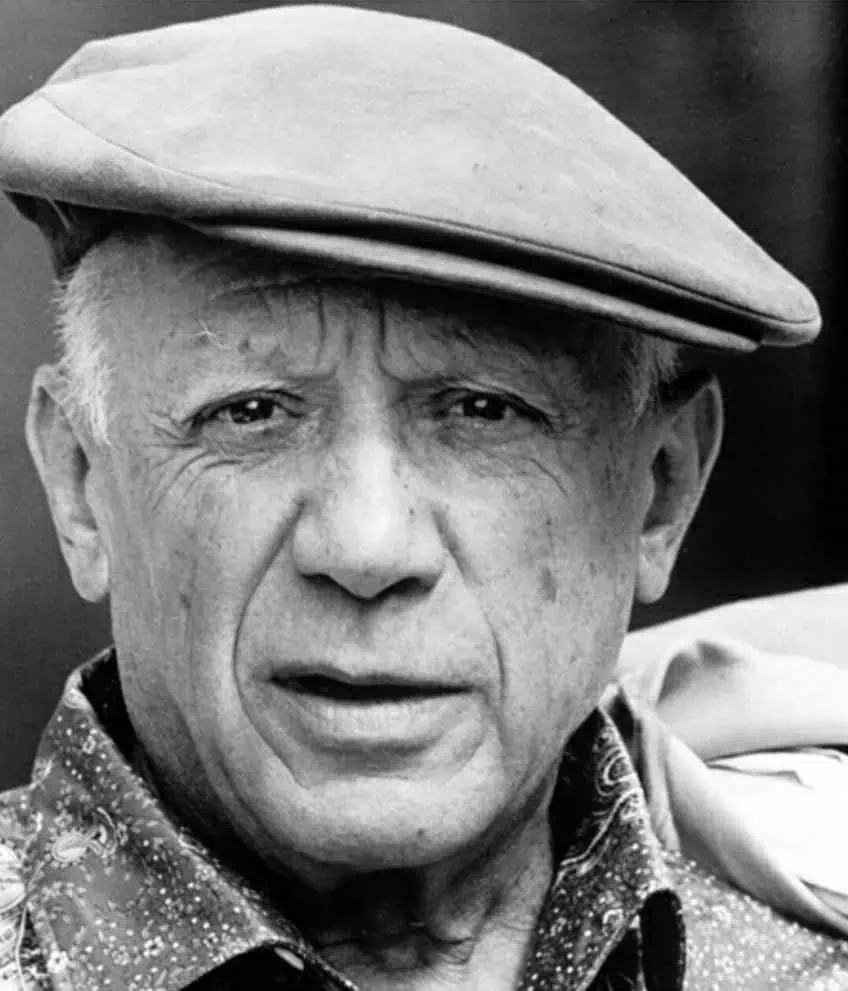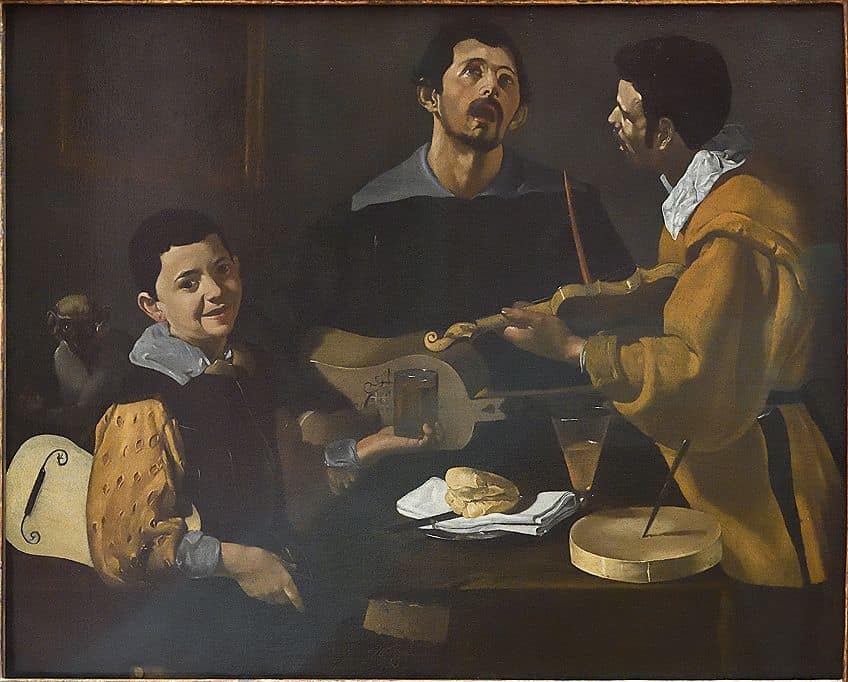“Three Musicians” by Pablo Picasso – A Detailed Painting Analysis
Pablo Picasso was not only a renowned painter but also a lover of music. Throughout his artistic career, he found inspiration in the musical world, creating numerous pieces that depict musicians and musical instruments. This article will delve into one such work, Three Musicians, highlighting Picasso’s unique interpretation of the subject and its place within the wider context of his oeuvre.
Contents
Artist Abstract: Who Was Pablo Picasso?
Pablo Picasso, born in Malaga, Spain in 1881, is considered one of the most noteworthy artists of Modern art history. His innovative style and technical prowess have cemented his place in the pantheon of great artists. Picasso showed an early aptitude for art and began formal training as a teenager at the Academy of Fine Arts in Barcelona. He later moved to Paris where he was exposed to the works of the Impressionists and developed his own unique style. His early paintings, such as The Old Guitarist (1903 – 1904) and Science and Charity (1897), showcased his mastery of traditional techniques and his sensitivity to human suffering.

Picasso’s most famous paintings include Les Demoiselles d’Avignon (1907), Guernica (1937), and The Weeping Woman (1937). Les Demoiselles d’Avignon was a groundbreaking work that is often considered the birthplace of Cubism, a movement in which Picasso played a major role. Guernica was a powerful political statement against the bombing of a Spanish town during the Spanish Civil War. The Weeping Woman is a haunting portrait of a woman in mourning, her tears flowing like a river. Picasso’s influence on the art world cannot be overstated. He was not only a master of traditional techniques but also a pioneer of new styles and ideas. He was constantly experimenting and pushing the boundaries of what was considered art.
In addition to Cubism, he also made major contributions to Surrealism, Expressionism, and other modern art movements.
Three Musicians by Pablo Picasso in Context
| Date | 1921 |
| Medium | Oil on canvas |
| Movement | Synthetic Cubism |
| Dimensions (cm) | 209.6 × 194.3 |
| Location | Museum of Modern Art (MoMA), New York City, United States |
Three Musicians by Pablo Picasso painting, created in 1921, is a powerful representation of the social and political climate in France during the post-World War I era. The painting, which features three grotesquely distorted figures playing musical instruments, reflects the artist’s response to the disillusionment and anxiety that plagued French society at the time. There have been many artistic renditions of the three musician trope throughout history, and Picasso harnessed this celebration of life and culture within this context.

In the aftermath of World War I, France was in a state of disarray, with the country experiencing a sense of loss and confusion. The trauma of the war had left a lasting impact on the nation, and people were searching for new ways of understanding their place in the world. Against this backdrop, Picasso’s Three Musicians served as a symbol of the fragmented and chaotic society that existed at the time. The Three Musicians painting is also significant because it represents a shift in Picasso’s artistic style. The painting marks the transition from his earlier work, which was characterized by a more naturalistic style, to his later work, which was heavily influenced by the Cubist movement.
In this sense, Three Musicians serves as a bridge between two important phases in Picasso’s career and is a testament to his versatility and creative vision and can be described as being a part of Picasso’s Synthetic Cubism phase.
Three Musicians Painting Analysis
Three Musicians by Pablo Picasso is a powerful example of the artist’s unique style, blending elements of cubism and modernism. Let us consider the choices Picasso made in terms of composition, subject matter, color, light, texture, perspective, and symbolism in this Three Musicians painting analysis.
Compositional Overview
The composition is characterized by a fragmented and abstract treatment of form, creating a dynamic interplay between the three figures that are playing music. The musicians are arranged in a diagonal line, with the central figure facing forward and the two others turned slightly to the side.
The flat planes of color and the sharp angles of the forms give the painting a sense of tension and energy, drawing the viewer’s eye into the dynamic movement of the figures.
Subject Matter
The subject matter of the painting is a group of musicians, a theme that was recurrent in Picasso’s work throughout his career. The figures are not realistically depicted but rather fragmented and simplified, reflecting the influence of cubism on the artist’s style. The central figure is wearing a harlequin costume, a reference to the commedia dell’arte, a traditional Italian theater form that was popular in the 17th and 18th centuries. The two other figures are dressed in simple clothing and are holding musical instruments, a guitar, and a clarinet.
Color and Light
The color palette of Three Musicians is characterized by a limited range of muted tones, with browns, grays, and blues predominating. The muted palette creates a sense of harmony, while the lack of light and shadow gives the painting a flat and two-dimensional appearance.
The monochromatic palette also serves to focus the viewer’s attention on the forms and shapes in the painting, creating a strong visual impact.
Texture
The texture of the painting is created through the layering of flat, angular forms, creating a sense of depth and movement. The forms overlap and interlock, giving the painting a sense of complexity and dynamism. The brushwork is loose and impasto, adding to the sense of texture and giving the forms a sculptural quality.
Perspective
The perspective in Three Musicians is fragmented and abstract, reflecting the influence of cubism on Picasso’s style. The forms are distorted, and the planes are angled, creating a sense of movement and energy. The forms are not depicted from a single viewpoint but rather from multiple perspectives, reflecting the complex and dynamic nature of the subject matter.
The fragmentation of form also creates a sense of ambiguity and uncertainty, adding to the painting’s sense of mystery.
Symbolism
Finally, the symbolism of Three Musicians is open to interpretation, reflecting the complex and multilayered nature of Picasso’s work. The central figure, dressed in the harlequin costume, can be seen as a representation of the artist himself, while the other two figures symbolize the musician and the audience. The painting can also be seen as a meditation on the power of music to bring people together, or as a celebration of the creative spirit.

In conclusion, Three Musicians by Pablo Picasso is a masterful work of art that showcases the artist’s distinctive style and remarkable abilities. This painting, created during Picasso’s Synthetic Cubism phase, blends elements of reality and abstraction, and its bold use of color and form reflect the artist’s experimentation with new ideas and techniques.
Frequently Asked Questions
Why Is Picasso Seen As Such an Influential Artist?
Picasso’s impact on art history extends far beyond his paintings and sculptures. He was a true innovator who inspired countless artists and continues to be an inspiration to this day. Whether you love or hate his work, there is no denying that Picasso’s legacy has left a lasting impression on the art world, and will continue to be celebrated for generations to come.
What Is the Political Significance of Three Musicians by Pablo Picasso?
Picasso’s Three Musicians painting is a powerful representation of the social and political climate in France during the post-World War I era. Through its distorted figures and bold use of color, the painting serves as a symbol of the fragmented and chaotic society that existed at the time, reflecting the mood of disillusionment and the anxiety that plagued the nation.
What Did Picasso Depict in Three Musicians?
In this painting, the three musicians are depicted as disjointed, awkward figures that seem to be disconnected from one another. The instruments they play are also distorted, suggesting the loss of order and structure in society. This distorted reality, combined with the use of bold and vivid colors, creates a sense of unease and instability, reflecting the mood of the time.
Nicolene Burger, a South African multimedia artist and creative consultant, specializes in oil painting and performance art. She earned her BA in Visual Arts from Stellenbosch University in 2017. Nicolene’s artistic journey includes exhibitions in South Korea, participation in the 2019 ICA Live Art Workshop, and solo exhibitions. She is currently pursuing a practice-based master’s degree in theater and performance. Nicolene focuses on fostering sustainable creative practices and offers coaching sessions for fellow artists, emphasizing the profound communicative power of art for healing and connection. Nicolene writes blog posts on art history for artfilemagazine with a focus on famous artists and contemporary art.
Learn more about Nicolene Burger and about us.
Cite this Article
Nicolene, Burger, ““Three Musicians” by Pablo Picasso – A Detailed Painting Analysis.” artfilemagazine – Your Online Art Source. March 10, 2023. URL: https://artfilemagazine.com/three-musicians-by-pablo-picasso/
Burger, N. (2023, 10 March). “Three Musicians” by Pablo Picasso – A Detailed Painting Analysis. artfilemagazine – Your Online Art Source. https://artfilemagazine.com/three-musicians-by-pablo-picasso/
Burger, Nicolene. ““Three Musicians” by Pablo Picasso – A Detailed Painting Analysis.” artfilemagazine – Your Online Art Source, March 10, 2023. https://artfilemagazine.com/three-musicians-by-pablo-picasso/.


